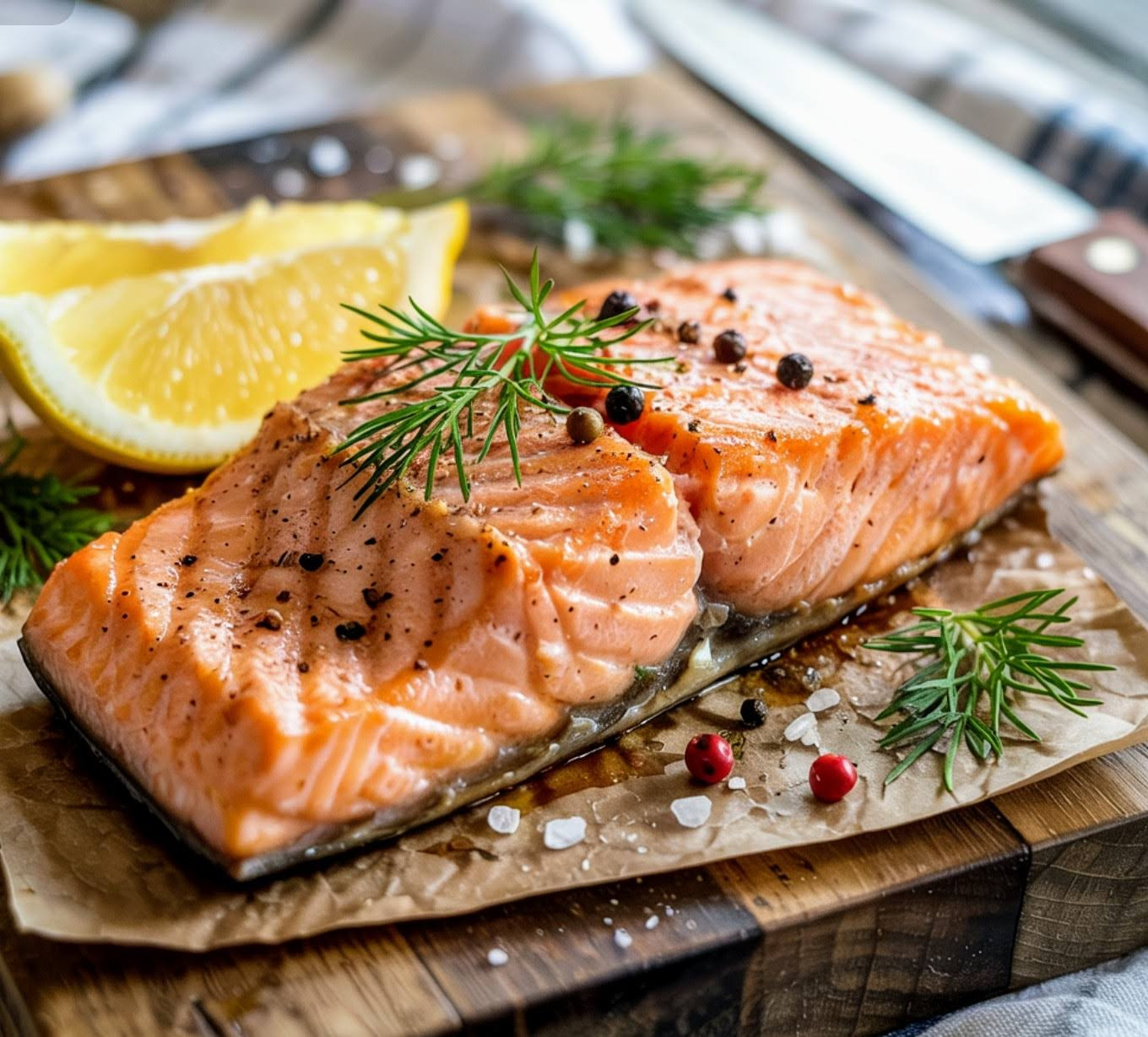Scottish Salmon Skin On
Scottish Salmon is a type of Atlantic Salmon from the waters around Scottland. It's known for it's vibrant orange color, mild flavor, and buttery texture. In addition, the cold, fast-moving waters produce strong fish that are high in fat content. Simple Grill, Bake or Broil. You will be extremely thrilled with this unique salmon.
Scottish Salmon (8oz) refers to wild-caught or farmed salmon from Scotland, known for its high quality, rich flavor, and tender texture. Scottish salmon is often considered a premium product due to the pristine waters where it’s raised, and it's prized for its fine marbling and natural taste. The 8oz portion is a perfect size for individual servings, typically ideal for grilling, baking, pan-searing, or broiling.
How to Cook Scottish Salmon (8oz):
Scottish salmon is incredibly versatile and can be cooked in many different ways. Below are some popular methods to prepare an 8oz portion of Scottish salmon:
1. Pan-Seared Scottish Salmon:
Pan-searing is a quick and easy method that creates a crispy crust while keeping the fish tender and moist on the inside.
Ingredients:
-
8oz Scottish salmon fillet
-
1 tbsp olive oil or butter
-
Salt and pepper
-
Fresh lemon wedges
-
Fresh herbs (optional)
Instructions:
-
Season the Fish: Pat the salmon dry with paper towels. Season both sides with salt and pepper.
-
Heat the Pan: Heat olive oil or butter in a skillet over medium-high heat.
-
Cook the Salmon: Place the salmon skin-side down (if it has skin) in the pan. Cook for about 4-5 minutes on the skin side until crispy. Flip the salmon and cook for another 2-3 minutes on the other side, or until it reaches your desired doneness (salmon should be opaque but moist inside).
-
Serve: Garnish with fresh lemon wedges and herbs. Serve with a side of roasted vegetables, salad, or rice.
2. Baked Scottish Salmon:
Baking is a gentle cooking method that preserves the delicate flavor of Scottish salmon.
Ingredients:
-
8oz Scottish salmon fillet
-
2 tbsp olive oil
-
1 tbsp fresh lemon juice
-
1 tsp dried herbs (like thyme or dill)
-
Salt and pepper
Instructions:
-
Preheat the Oven: Preheat your oven to 400°F (200°C).
-
Prepare the Fish: Place the salmon fillet on a baking sheet lined with parchment paper or lightly greased.
-
Season: Drizzle with olive oil and lemon juice. Sprinkle with dried herbs, salt, and pepper.
-
Bake: Bake for about 12-15 minutes or until the salmon flakes easily with a fork.
-
Serve: Serve with a side of quinoa, steamed asparagus, or a light salad.
3. Grilled Scottish Salmon:
Grilling adds a delicious smoky flavor to Scottish salmon, making it perfect for warm weather dining.
Ingredients:
-
8oz Scottish salmon fillet
-
1 tbsp olive oil
-
Salt and pepper
-
Fresh lemon slices for garnish
Instructions:
-
Preheat the Grill: Preheat the grill to medium-high heat.
-
Prepare the Fish: Brush the salmon fillet with olive oil and season with salt and pepper.
-
Grill: Place the salmon on the grill and cook for about 4-5 minutes per side, depending on thickness. Use a grill spatula to flip the salmon gently.
-
Serve: Serve with a squeeze of fresh lemon juice and a side of grilled vegetables or a fresh salad.
4. Broiled Scottish Salmon:
Broiling is a great way to cook salmon quickly while achieving a slightly crispy exterior.
Ingredients:
-
8oz Scottish salmon fillet
-
2 tbsp melted butter
-
1 tbsp lemon juice
-
Salt and pepper
-
Fresh herbs for garnish (optional)
Instructions:
-
Preheat the Broiler: Preheat your broiler on high.
-
Prepare the Fish: Place the salmon fillet on a broiler pan or a baking sheet lined with foil. Brush with melted butter and lemon juice. Season with salt and pepper.
-
Broil: Place the salmon under the broiler about 6 inches from the heat source. Broil for about 4-6 minutes, or until the salmon is cooked through and flakes easily.
-
Serve: Garnish with fresh herbs and serve with your favorite sides.
5. Poached Scottish Salmon:
Poaching salmon is a great method to keep it tender and moist, perfect for those who want a lighter preparation.
Ingredients:
-
8oz Scottish salmon fillet
-
2 cups fish stock or water
-
1/2 cup white wine (optional)
-
1 lemon, sliced
-
Fresh herbs (dill or thyme)
-
Salt and pepper
Instructions:
-
Prepare the Poaching Liquid: In a shallow pan, combine the fish stock or water with white wine (optional), lemon slices, and fresh herbs. Bring to a gentle simmer.
-
Poach the Fish: Add the salmon fillet to the simmering liquid. Cover the pan and cook for about 10 minutes, or until the salmon is cooked through and flakes easily.
-
Serve: Serve the poached salmon with a light sauce (such as a dill yogurt sauce) and steamed vegetables.
Health Benefits of Scottish Salmon:
-
High in Omega-3 Fatty Acids: Scottish salmon is rich in heart-healthy omega-3 fatty acids, which help reduce inflammation and promote cardiovascular health.
-
Rich in Protein: Like other types of salmon, Scottish salmon provides a high-quality source of protein, essential for muscle growth and repair.
-
Vitamins and Minerals: Scottish salmon is an excellent source of vitamin D, B vitamins (especially B12), and minerals like selenium, which support bone health, energy production, and immune function.
-
Low in Mercury: As a farmed fish, Scottish salmon is generally lower in mercury than some other types of larger fish, making it a safer choice for regular consumption.
Tips for Cooking Scottish Salmon:
-
Don’t Overcook: Overcooked salmon can become dry and tough. For the perfect cooked salmon, aim for medium-rare to medium doneness. The fish should be just opaque and moist inside.
-
Skin-On vs. Skinless: If you have skin-on salmon, make sure to cook it skin-side down to help protect the delicate flesh from overcooking. The skin crisps up nicely and adds texture.
-
Use Fresh Herbs: Fresh herbs like dill, parsley, thyme, and tarragon pair wonderfully with salmon and enhance its natural flavor.
-
Rest Before Serving: After cooking, let the salmon rest for a few minutes before serving. This helps redistribute the juices and keep it moist.
Scottish salmon is a versatile, healthy, and delicious choice for a variety of cooking methods, from grilling to poaching. Whether you're preparing it simply with lemon and herbs or using more complex techniques like broiling or pan-searing, it’s sure to impress at the dinner table. Let me know if you need any additional recipes or tips!

